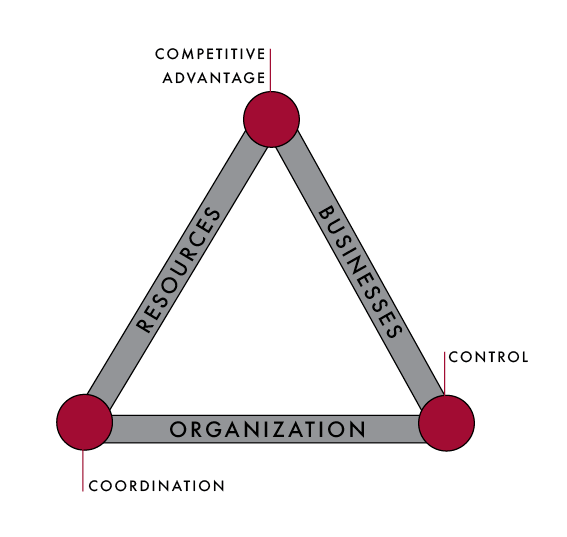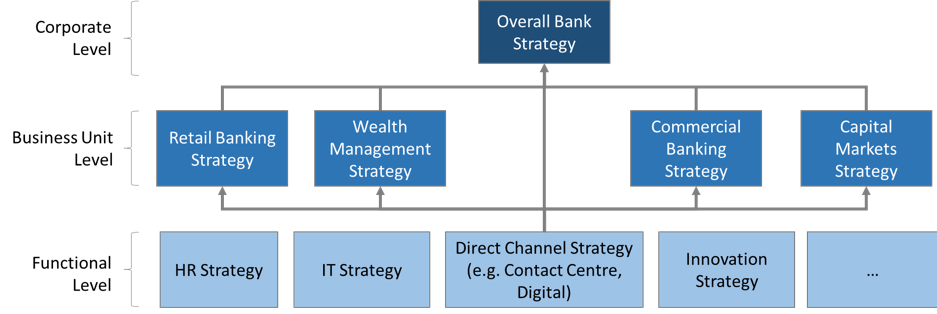What is corporate strategy?
Corporate strategy is a unique plan or framework that is long-term in nature, designed with an objective to gain a competitive advantage over other market participants while delivering both on customer/client and stakeholder promises (i.e. shareholder value).
Another, much simpler corporate strategy meaning is to see it as a set of decisions where a company would place its bets for the future. Given that every organization has a limited amount of resources, it needs to decide how it will prioritize using these resources.
In this article, we offer a deep dive into corporate strategy.
- Types of corporate strategy
- Why does good corporate strategy matter?
- 10 Corporate strategy components
- Corporate strategy vs Business strategy vs Functional strategy: How are they different?
- Michael Porter’s four corporate strategy types
- Red ocean strategy vs Blue ocean strategy
- Examples of highly successful corporate strategies
- Video: David Burnie discusses good corporate strategy
- Our insights on strategy
- Our strategy leaders
Key takeaways
-
Corporate strategy is about making long-term, focused choices with limited resources
-
A good corporate strategy relies on a coherent set of components, not vague visions or wish lists
-
Corporate strategy sits above business-unit or functional strategy, it defines the portfolio and direction for the whole enterprise
Different types of corporate strategy
Though no two strategies are ever the same, corporate strategy can be classified into four different groups:
- Growth strategy
- Stability strategy
- Retrenchment strategy
- Re-invention strategy
Each type of corporate strategy has several sub-types, as illustrated in the picture below.
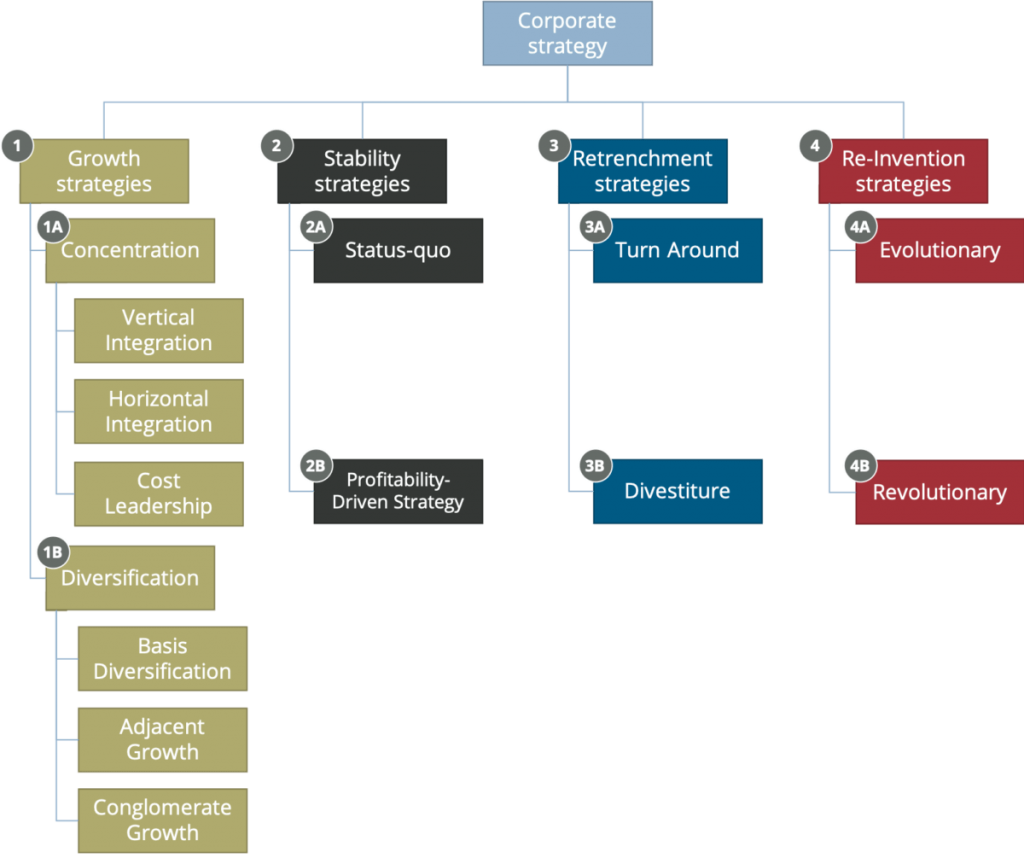
Here is a brief overview of each strategy type with examples:
Growth strategies aim to achieve considerable business growth in the areas of revenue, market share, penetration, etc. This can be achieved either through concentration where the company is still focusing on its core business and builds it out or through diversification where a company decides to diversify based on the number of approaches that are described in detail below.
1A. Concentration
If a company aspires to growth while remaining in the same space it is currently operating, this is a concentration growth strategy. Here it is important to distinguish between a few options:
• Vertical Integration (participating in more value-added activities)
• Horizontal Integration (same activities, different geography or different
Vertical Integration
Vertical Integration (i.e. executing on more value chain steps than in the past e.g. by being involved in distribution activities, supplier activities, etc.)
An example of a vertical integration would be a travel agent who gets licensed in order to not only sell travel packages but also receive commission from travel insurance sales (a product that is often sold in tandem with travel packages)
Horizontal Integration
Horizontal integration assumes expansion into other geographies and/or the offering other products/services into the same market where the company already operates. An example of horizontal integration would be the expansion of Tim Hortons into the United States or expansion into lunch meals within its existing Canadian market.
1B. Diversification
Diversification is a very wide-spread type of strategy that may include the aspiration of the company to grow based on changes in product/service offering, introducing new products services, or even moving into entirely new spaces.
Basis diversification
Basis diversification means that a company preserves its current offering, but is able to differentiate its product/service from other competitors by unique capabilities/features/ characteristics. In this case, a product/service value-added in the eyes of a customer/client is higher. As a rule, it justifies a higher price.
Cost leadership
Cost leadership is a special type of concentration strategy where a company is able to offer the same product/service at a more attractive price (e.g. via superior, more cost-efficient Operations).
For example, this strategy can be seen with Mazda offering its more affordable vehicles that are competitive with other players in a higher price bracket in terms of quality and functionality, but at a lower price point.
Adjacent growth
Adjacent growth is an exciting strategy space for any organization. This strategy is often reliant on an organization feels that it has reached its limits in its core business. In this case, a company explores opportunities to grow in a space related to its core business – it can be an additional product/service, adjacent industries, additional set of customers, etc. For adjacent strategies, it is important to identify the most promising adjacent niches and “attack” them instead of boiling the ocean of potential opportunities. If an online platform has been comparing banking products and then decided to move into the comparison of insurance products, that would be an adjacent growth strategy.
Conglomerate growth
Conglomerate growth is the opposite of basis diversification. It means that an organization looks to expand into businesses which are not (or are but very loosely) linked to its core. There are fewer synergies across such businesses but nevertheless, this strategy has shown to be feasible for many companies. In some cases, it is a strong brand that allows a company to propel the conglomerate business e.g. in the case of Virgin Group.
Stability strategies do not have growth and new business development in their focus but rather are geared towards getting “more” out of the existing business (i.e. profitability-driven-strategy) or “stay-as-it-is” (i.e. Status-quo strategy) because the current situation already works well for the organization.
2A. Status-quo
Status-quo strategies often focus on maintaining the existing performance of a business and can include such elements as acquisition of potential companies that pose a threat to the existing business, work with regulators to develop business entry barriers, etc. The reasons to choose a status-quo strategy can be varied e.g. already being very successful, not having opportunities for growth, regulatory regulations, etc.
2B. Profitability-driven
A profitability-driven strategy is often linked to a desire to boost company evaluation (e.g. prior to selling the business, before an initial public offering) and has enterprise value in the focus of the strategy. The variety of levers used for this strategy type spans across portfolio optimization, cost-cutting, adjustment of pricing, etc.
This set of strategies is almost the opposite of status-quo or growth strategies. It is a defensive strategy where the main objective is to change the negative trajectory and improve the company’s position either through aggressive changes or “cutting off” the parts that pull it down.
3A. Turnaround
A turnaround strategy is based on a dramatic change from the previous course of action (e.g. due to a bad decision, company mismanagement, loss of market share, shrinking industry, etc.) It includes such measures as crisis management, financial restructuring of the company, revamping the company’s product and servicing, aggressive cost-saving initiatives e.g. via robotic process automation, employee retention, etc. In most cases, implementing a turnaround strategy is a heavy exercise for the entire organization that touches every single part of a company.
3B. Divestiture
Divestiture strategy involves ‘getting rid’ of parts of a business for a number of reasons such as a decision to focus on the core businesses (e.g. when a business line does not fit into the overall business landscape), the poor performance of certain business lines, attractive sale opportunities, etc. Divestiture strategies typically lead to lower complexity of the rest of the business and releasing a part of resources that can be reinvested into the business lines a company decides to keep.
Re-invention strategies often include taking the existing industries/businesses which have not changed for decades and re-inventing them, often with the support of new technologies. Here one can distinguish between evolutionary strategies and revolutionary strategies.
4A. Evolutionary
Evolutionary strategies typically do not change the business model but strongly evolve the way service is delivered; they can significantly change a company’s product/service because they unlock a new dimension of value for customers. An example of such a business would be Netflix where the movies are delivered not as physical rentals (i.e. Blockbuster) but through a digital subscription.
4B. Revolutionary
Revolutionary strategies often change the entire business model unlocking value for existing and new stakeholders. That often leads to significant shifts in market dynamics. Some technologies such as blockchain and artificial intelligence are seen as enablers that will fuel many reinventions and must be seen as a fundamental component of any technology strategy plan. Uber can serve as an example of such a business where it fully re-invented the way people provide and use rental car services impacting both drivers (i.e. new drivers, existing taxi drivers) and passengers.
Learn more about Burnie Group's strategy consulting.
READ MOREWhy does good corporate strategy matter?
While still a relatively young discipline, corporate strategy has made incredible strides in the business world over the past 40 years. Concerned with the overall purpose and scope of the business to meet stakeholder expectations, corporate strategy is heavily influenced by investors in the business and acts to guide strategic decision-making throughout the enterprise at all levels.
To succeed, a good strategy needs both a solid foundation and the ability to evolve and change in real-time. Business is not static, corporate strategy shouldn’t be either.
Organizations face several challenges when designing and putting into practice corporate strategies. So, what exactly is the foundation of a solid corporate strategy?
A good corporate strategy consists of six elements that together promote a corporate advantage. These elements can be represented in a Corporate Strategy Triangle, where the sides of the triangles are the foundations of a solid strategy: Resources, Businesses, Organization.
The importance of corporate strategy is in focusing on an organization with all its resources and capabilities on accomplishing clearly defined mid- and long-term objectives.
Professor Richard Rumelt of UCLA argues that where companies go wrong is when they make their strategy too complicated. It is also by our natural tendency to try and satisfy all possible constituencies (the CEO, the Board, key investors, etc.), it is here that strategies often become convoluted and lose focus.
To achieve a competitive advantage, each arm of the triangle has to be strong enough to support the triangle uniformly, yet flexible enough to evolve with the business. The business must be in a position to leverage this triangle of strengths to bring about a competitive advantage. The point is when these three arms of the triangle do not match up, any advantage that a business has eventually fallen away.
10 Components of corporate strategy
A good corporate strategy is more than a description of the company’s vision or mission. It is not a long list of tasks that need to be accomplished. We believe that a good corporate strategy has several essential components:
- A set of clearly defined objectives which are quantified, anchored in financials (e.g. enterprise value, profitability, growth) and linked to a timeline
- A clearly defined product or/and service offering that clarifies four dimensions:
- What products/services do we offer (including clearly defined value-added)?
- Who is our customer/client?
- What markets do we serve (e.g. geography)?
- At what price do we offer our product/service?
- A clear understanding of the market/industry and competitive landscape
- Core capabilities that the organization has AND does not have (e.g. innovation, cost advantage, etc.)
- Execution approach defining how objectives will be achieved (e.g. through organic growth, acquisitions, etc.)
- Key elements of performance management to track the execution journey (e.g. KPIs)
- Agreed risk management approach (i.e. identified risks and mitigation strategies)
- Clear change management and leadership approach to drive changes necessary to succeed.
- A clearly defined strategic roadmap laying out the path forward (i.e. milestones, activities, responsibilities, associated resources, etc.)
- A well-defined strategy considers different scenarios that represent potential strategic developments and feasible versions of future developments to ensure that the company is prepared for unexpected.
For example, if a company plans for essential growth that includes both organic and acquisition-based growth, it should have in its back pocket a scenario of a “pure organic growth” in the event that there are no companies in the market to acquire. Another possible scenario is changes in regulation that are often hard to predict.
Learn more about our strategy leaders.
READ MORECorporate strategy vs Business strategy vs Functional strategy: How are they different?
Very often people talk about different types of strategies referring to strategies that relate only to a particular part of an organization. Often, there is a confusion when talking about corporate strategy vs business strategy vs functional strategy. Let us clarify the differences.
Typically, there are three different levels of strategies to distinguish between:
- Corporate strategy
- Business strategy (also called business level strategy), and
- Functional Strategy
Here is a summary of differences across these three types and key questions that each strategy should address.
| STRATEGY FOCUS | EXAMPLES OF QUESTIONS COVERED |
| Business strategy (or business level strategy or business unit strategy) determines the path forward for a particular business and customers/clients it is focusing on. Such aspects as profitability, sustainability, product/service offering, pricing, customer/client segmentation are focal topics of a business strategy. | 1. What are the services and products we want to provide our customers/clients?
2. In what geographies/market segments we want to play? 3. How can we drive profitability why delivering better products/services? |
| STRATEGY FOCUS | EXAMPLES OF QUESTIONS COVERED |
| Functional strategy deals with a path forward for a particular organization function (e.g. HR, Contact Centre, Digital, Technology/IT) in the context of the entire organization (i.e. how this function adds value to the rest of the organization). Such as aspects as services offered, internal pricing, enabling capabilities, quality of services are in the focus of a functional strategy | 1. How can we best enable both internal end external clients?
2. How can we deliver the best quality of services in an efficient way? 3. How can we help create synergies and apply best-practices serving various parts of the organization? |
| STRATEGY FOCUS | EXAMPLES OF QUESTIONS COVERED |
| The focus of the corporate strategy is on the entire organization. It determines the path to create value both for shareholders and clients/customers. The strategy spans across the entire portfolio of businesses owned by the company and functions that enable and empower these businesses. | 1. How we add value to shareholders / increase enterprise value?
2. What are the key businesses we want to be in? What are internal (for our company) and external (for our customers/clients) synergies between our businesses? |
Here is an example of how various strategy levels may look in a bank. An overall bank strategy is supported/aligned with business strategies of every single business unit (e.g. Retail Banking, Wealth Management, Commercial Banking, Capital Markets). At the same time, functional strategies (e.g. HR strategy, IT strategy, Operations Strategy, Direct Channel Strategy, Innovation Strategy, etc.) must support both Business Units but also the bank itself on the corporate level.
Michael Porter’s four corporate strategy types
The different strategy types shown above are not the only ones that exist. Michael Porter’s four corporate strategy types are one of the most widely recognized ways of distinguishing different strategies.
According to Porter, these are the two distinguishing factors in strategies:
- The breadth of the market a company wants to cover (also called market focus)
- A strategic advantage that can be either low cost or unique product/service capabilities.
That results in four different types of corporate strategy types:
| Narrow market + Low cost capability = Focus strategy | Narrow market + Unique product / service capability = Focus strategy |
| Broad market + Low cost capability = Cost leadership strategy | Broad market + Unique product / service capability = Differentiation strategy |
These strategies represent a subset of strategies we mentioned earlier, mainly growth strategies, and do not account for strategies targeting maintaining status quo, divestiture, and as seen in many recent examples, re-invention strategies.
Red ocean strategy vs Blue ocean strategy
Two other terms that are often used in the strategy context are RED OCEAN STRATEGY and BLUE OCEAN STRATEGY. These two again, represent a bit of a different view on the corporate strategy types mentioned above.
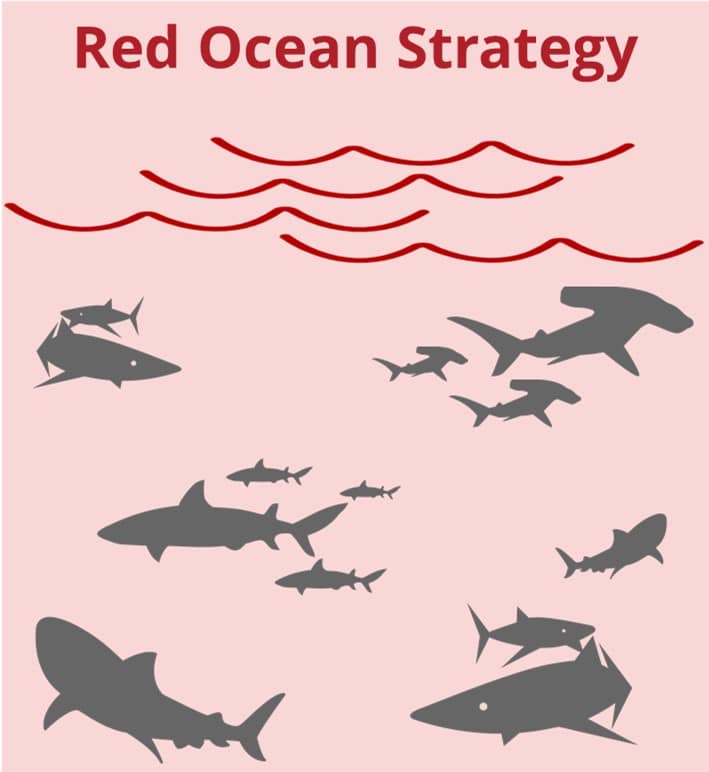
|
Red ocean strategy means that a company chooses to compete in a market with plenty of competitors (RED = bloody fight for leadership). This strategy focuses on existing demand and requires a company to have specific or niche capabilities to differentiate itself from its competitors e.g. low-cost offering, unique product/service capabilities. The main potential for growth, when using this type of strategy, comes from “re-distribution” and “winning/losing” market share and that can be limited. |
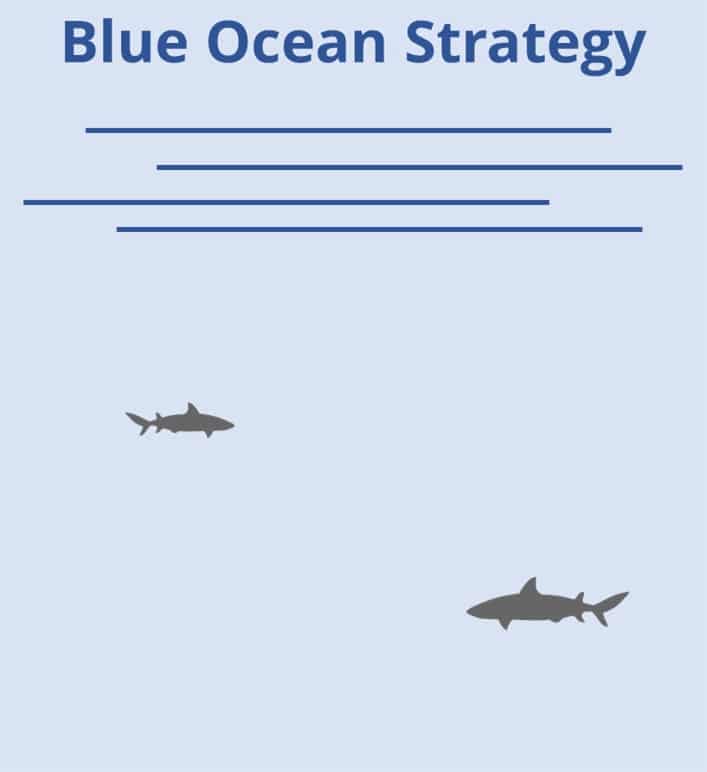
|
Blue ocean strategy means that a company chooses to address a new market with unaddressed demand. This space does not have significant competition yet and often offers vast opportunities for growth (BLUE = deep, calm ocean). It can be very promising but also carries a significant uncertainty since there are no other successful players to look up to and learn from. |
Examples of highly successful corporate strategies
Below are two well-known examples of successful strategic initiatives.
Porsche’s corporate strategy example

Vehicles like the 911 (midsize premium sport vehicle), Boxster (compact, premium sport vehicle), and Cayman (premium sport coupe) targeted a very specific upscale market, allowing the company to focus its brand and value proposition on this segment of consumers. Additionally, the company introduced new products like the Cayenne (one of the first luxury sport SUVs) targeting wealthy consumers in the market for a luxurious four-door sport vehicle.
This carefully designed and brilliantly executed strategy resulted in highest profit margins across the industry (~15%), comparatively other players found themselves far behind in terms of profitability (2016 numbers) e.g. Mercedes (~7%) or Hyundai (~4%)
It is interesting to know that Porsche’s profitability is by far higher than that of its parent company, Volkswagen.
Toyota’s corporate strategy example
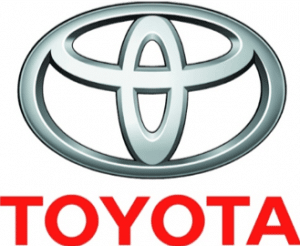
In order to deliver on both core objectives, Toyota focused on operations excellence introducing manufacturing and lean concepts that were widely embraced later by other manufacturers in the automotive space and beyond. Such terms as TPS (Toronto Production System), JIT (Just-in-time) manufacturing and LEAN are known to originate in Toyota’s manufacturing.
This has enabled the company to offer high-quality products (though in clearly defined configurations) at very competitive prices quickly capturing a significant share of the automotive market. Toyota’s profits per vehicle are not comparable with those of Porsche but they are able to capture a much larger market compensating for lower margins.
Is your organization considering developing a new strategy or refreshing an existing one and would like to have external support? We look forward to talking to you about our strategy practice.
David Burnie discusses good corporate strategy
Hi, I’m David Burnie, Founder of Burnie Group. I lead our Strategy and Operations practice.
One of the questions I often get is, What is the strategy? And how can Burnie Group help us build our corporate or business strategy?”
For me, a strategy is all about deploying resources effectively and making choices. So, when we work with an organization we frequently think about how can we help an organization take the limited resources it has and deploys that in the most effective way. Often that starts with the problem. What is the problem your company is trying to solve? or in another way, what is your mission and vision? Frequently we find when we work with a company that they haven’t defined the problem they are trying to solve. They don’t have a very clear mission or vision, and they haven’t gone through the thinking to ensure that what they are doing really resonates with their customers.
One example, we worked with a client who is a very data-driven organization and they were doing quite well, but what we found was all the data they were collecting was extremely valuable and could be deployed in a much better way if they really became an insights-driven company. The data became the foundation for insights which were much more valuable for their customers.
When we work with companies, we think about a process where we first go and define the mission and vision but then we’ll actually work with them, assess the current environment, we’ll look at their competitors, regulation, what’s going on in the industry, customers, consumers, and really understand their industry as a whole and what the opportunities are. How it’s growing, how it’s changing, how technology will impact it going forward.
Once we’ve done that, we’ll have a very inclusive exercise where we bring all the leadership together, we’ll roll up our sleeves, and we’ll educate them on everything we’ve researched. Helping them start to make some informed decisions. How do you prioritize? What are the opportunities? and how do we as a leadership team align on what opportunities we as an organization want to pursue?
Then, once you’ve identified what those opportunities are we essentially have a set of strategic initiatives. We can then work very closely with an organization to put plans in place to build out those strategic initiatives, what we would call a roadmap.
Focusing on the short term, medium term, and long term. We can put together very clear action plans to help an organization go after those strategic opportunities and deliver on the strategy that we have built together.
Read more of our insights on strategy
5 Impactful Things to Learn by Observing Branch Operations with a Critical Eye
Frequently asked questions
Why does a company need a corporate-level strategy instead of just strategy at the business-unit level?
Because corporate strategy ensures alignment across the entire enterprise, it defines which businesses to pursue (or exit), how resources are allocated, and leverages potential synergies across units. Without it, individual business units may optimize their own performance but conflict with each other or misuse shared resources.
What distinguishes a good corporate strategy from simply having a mission statement or vision?
A mission or vision alone is too vague; a good corporate strategy goes much further. It specifies concrete objectives (often financial), provides clarity on offerings, markets, customers, pricing, maps core capabilities, outlines how to execute, builds in performance metrics and risk-management, and defines a roadmap, often with scenario-planning to handle uncertainty.
How flexible should a corporate strategy be? Should it stay fixed or evolve over time?
According to the article, a good corporate strategy must combine a solid foundation with the ability to evolve in real time. Because business environments change (market shifts, competition, regulation, technology), strategy needs to adapt, but without losing focus on long-term objectives and core capabilities.
Our strategy leaders
Find out how we can help you build your corporate strategy.
CONTACT US

